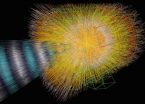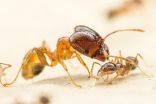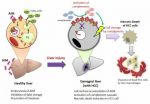The multi-institutional team known as the JET Collaboration, led by researchers at the U.S. Department of Energy's Lawrence Berkeley National Lab (Berkeley Lab), published their results in a recent issue of Physical Review C. The JET Collaboration is one of the Topical Collaborations in nuclear theory established by the DOE Office of Science in 2010. JET, which stands for Quantitative Jet and Electromagnetic Tomography, aims to study the probes used to investigate high-energy, heavy-ion collisions. The Collaboration currently has 12 participating institutions with Berkeley Lab as the leading institute.
"We have made, by far, the most precise extraction to date of a key property of the quark-gluon plasma, which reveals the microscopic structure of this almost perfect liquid," says Xin-Nian Wang, physicist in the Nuclear Science Division at Berkeley Lab and managing principal investigator of the JET Collaboration. Perfect liquids, Wang explains, have the lowest viscosity-to-density ratio allowed by quantum mechanics, which means they essentially flow without friction.
Hot Plasma Soup
To create and study the quark-gluon plasma, nuclear scientists used particle accelerators called the Relativistic Heavy-ion Collider (RHIC) at the Brookhaven National Laboratory in New York and the Large Hadron Collider (LHC) at CERN in Switzerland. By accelerating heavy atomic nuclei to high energies and blasting them into each other, scientists are able to recreate the hot temperature conditions of the early universe.
Inside protons and neutrons that make up the colliding atomic nuclei are elementary particles called quarks, which are bound together tightly by other elementary particles called gluons. Only under extreme conditions, such as collisions in which temperatures exceed by a million times those at the center of the sun, do quarks and gluons pull apart to become the ultra-hot, frictionless perfect fluid known as quark-gluon plasma.
"The temperature is so high that the boundaries between different nuclei disappear so everything becomes a hot-plasma soup of quarks and gluons," says Wang. This ultra-hot soup is contained within a chamber in the particle accelerator, but it is short-lived—quickly cooling and expanding—making it a challenge to measure. Experimentalists have developed sophisticated tools to overcome the challenge, but translating experimental observations into precise quantitative understanding of the quark-gluon plasma has been difficult to achieve until now, he says.
Looking Inside
In this new work, Wang's team refined a probe that makes use of a phenomenon researchers at Berkeley Lab first theoretically outlined 20 years ago: energy loss of a high-energy particle, called a jet, inside the quark gluon plasma
"When a hot quark-gluon plasma is generated, sometimes you also produce these very energetic particles with an energy a thousand times larger than that of the rest of the matter," says Wang. This jet propagates through the plasma, scatters, and loses energy on its way out.
Since the researchers know the energy of the jet when it is produced, and can measure its energy coming out, they can calculate its energy loss, which provides clues to the density of the plasma and the strength of its interaction with the jet. "It's like an x-ray going through a body so you can see inside," says Wang.
One difficulty in using a jet as an x-ray of the quark-gluon plasma is the fact that a quark-gluon plasma is a rapidly expanding ball of fire—it doesn't sit still. "You create this hot fireball that expands very fast as it cools down quickly to ordinary matter," Wang says. So it's important to develop a model to accurately describe the expansion of plasma, he says. The model must rely on a branch of theory called relativistic hydrodynamics in which the motion of fluids is described by equations from Einstein's theory of special relativity.
Over the past few years, researchers from the JET Collaboration have developed such a model that can describe the process of expansion and the observed phenomena of an ultra-hot perfect fluid. "This allows us to understand how a jet propagates through this dynamic fireball," says Wang.
Employing this model for the quark-gluon plasma expansion and jet propagation, the researchers analyzed combined data from the PHENIX and STAR experiments at RHIC and the ALICE and CMS experiments at LHC since each accelerator created quark-gluon plasma at different initial temperatures. The team determined one particular property of the quark-gluon plasma, called the jet transport coefficient, which characterizes the strength of interaction between the jet and the ultra-hot matter. "The determined values of the jet transport coefficient can help to shed light on why the ultra-hot matter is the most ideal liquid the universe has ever seen," Wang says.
Peter Jacobs, head of the experimental group at Berkeley Lab that carried out the first jet and flow measurements with the STAR Collaboration at RHIC, says the new result is "very valuable as a window into the precise nature of the quark gluon plasma. The approach taken by the JET Collaboration to achieve it, by combining efforts of several groups of theorists and experimentalists, shows how to make other precise measurements of properties of the quark gluon plasma in the future."
The team's next steps are to analyze future data at lower RHIC energies and higher LHC energies to see how these temperatures might affect the plasma's behavior, especially near the phase transition between ordinary matter and the exotic matter of the quark-gluon plasma.
INFORMATION:
This work was supported by the DOE Office of Science, Office of Nuclear Physics and used the facilities of the National Energy Research Scientific Computing Center (NERSC) located at Berkeley Lab.
Lawrence Berkeley National Laboratory addresses the world's most urgent scientific challenges by advancing sustainable energy, protecting human health, creating new materials, and revealing the origin and fate of the universe. Founded in 1931, Berkeley Lab's scientific expertise has been recognized with 13 Nobel prizes. The University of California manages Berkeley Lab for the U.S. Department of Energy's Office of Science. For more, visit http://www.lbl.gov.
DOE's Office of Science is the single largest supporter of basic research in the physical sciences in the United States, and is working to address some of the most pressing challenges of our time. For more information, please visit the Office of Science website at science.energy.gov.






